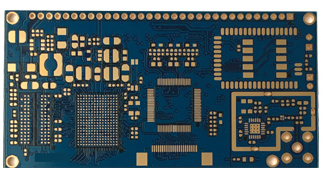PCB double-sided reflow process (SMT) is an introduction to circuit board assembly technology. Now the popular industry in the industry is full-board reflow soldering (Reflow). This technology can be divided into single-sided reflow soldering and double-sided reflow soldering. Single-sided reflow is used less, because double-sided reflow can save space on the circuit board. Double-sided reflow requires two reflows. Due to process limitations, some problems may arise. For example, when the board goes to the second reflow furnace, the parts on the first side will fall due to gravity, especially When the board flows into the reflow zone of the furnace at high temperatures.
So, what should be considered when doing double-sided reflow manufacturing? Which SMD parts should be placed on the first side through the reflow furnace?

First of all, it is recommended that the smaller parts be placed on the first side through the reflow oven, because the deformation of the PCB will be smaller when the first side is passed through the reflow oven, and the precision of solder paste printing will be higher, so it is better to put them together. Smaller parts. Secondly, the smaller parts will not be at risk of falling during the second pass through the reflow oven. Because the parts on the first side are placed directly on the bottom side of the circuit board when hitting the second side, when the board enters the reflow area, it will not fall off the board due to excessive weight. For more about designing PCB, welcome to visit Jiepei PCB. Thirdly, the parts on the first panel must go through the reflow oven twice, so its temperature resistance must be able to withstand the temperature of the two reflows. The general resistance capacitor is usually required to pass the high temperature of at least three reflows. This is to meet Some boards may need to go through the reflow furnace again due to maintenance.
Which SMD parts should be placed on the second side through the reflow furnace?
1. Large components or heavier components should be placed on the second side of the furnace to avoid parts falling into the reflow furnace during the furnace. LGA and BGA parts should be placed on the second side of the furnace as much as possible, so as to avoid unnecessary re-melting risks during the second furnace, so as to reduce the chance of empty/false soldering. If there are small BGA parts with fine feet, they can also be placed on the first side through the reflow furnace, as long as the PCB deformation can be effectively avoided.
2. Parts that cannot withstand too many high temperatures should be placed on the second side through the reflow furnace. This is to avoid damage to the parts due to too many high temperatures. PIH/PIP parts should also be placed on the second side to pass the furnace. Unless the length of the solder feet does not exceed the thickness of the board, the feet protruding from the PCB surface will interfere with the steel plate on the second side, causing the second side The steel plate printed with solder paste cannot be flatly attached to the PCB, which causes abnormal solder paste printing.
3. Some components may use soldering inside, such as a network cable connector with LED lights. It is necessary to pay attention to whether the temperature resistance of this part can pass through the reflow oven twice. If not, it must be placed on the second side. Pieces. Only the parts are placed on the second side of the reflow oven, which means that the circuit board has been baptized by the high temperature of the reflow oven. At this time, the PCB circuit board has somewhat warped and deformed, that is to say The printing volume and printing position of the solder paste will become more difficult to control, so it is easy to cause problems such as empty soldering or short circuit. Therefore, it is recommended that you try not to place 0201 and fine feet ( Fine pitch) parts, BGA should also try to choose a solder ball with a larger diameter.